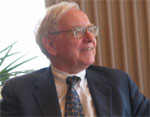 |
 |
 |
|
|
|
|||||||||||||||||||||||||||||||||||||||||||||||||||||||||||||||||||
|
Step 1 to Financial Success: Catch a Vision!
Most people lack a vision for their money. Headed nowhere, or pointed in some vague direction called "I need to do better and start saving some money," they plod to work each day and spend their paychecks by the next payday. It's hard to get excited about a vague desire to do better!
The Power of a Specific Vision
His financial vision took hold of him before he was five. (1) Seriously ill at age seven, he prophetically told a nurse, "I don’t have much money now, but someday I will and I’ll have my picture in the paper." In elementary school, he’d tell his classmates that he planned to be rich before his 35th birthday. (2)
Once he caught his vision, he could pursue it in very specific ways.
At age five, he set up a stand in front of his house and sold Chicklets. Then he progressed to lemonade, finding a better location at his friend’s house on a busier street. (3) On vacation at Lake Okoboji at age 6, he bought a six-pack of Cokes and sold them at a five cent profit per Coke. (4)
Before age 11, he hired neighborhood kids to find golf balls and paid others to sell them, taking his cut. He caddied for golfers at the Omaha Country Club for $3 a day. (5) But Warren’s vision went beyond merely making money. He thought long and hard about investing money. By age 11, he’d earned enough to begin investing, so he bought 3 shares of Cities Service preferred stock for $114 (that’s $1500 in 2005 dollars! (6)), which he later sold at a profit.
In the 8th grade, a family friend asked Warren about his drive to make money. "It’s not that I want money," he explained. "It’s the fun of making money and watching it grow." (7)
He continued the pattern of working, saving, investing. And he read everything he could get his hands on concerning business and finance. He grew a paper route into a profitable business, so that at the age of 14, he invested $1,200 ($12,800 in today’s money) in forty acres of Nebraska farmland. (8)
From his paper routes, pinball machines and rent from a tenant farmer, he was earning more money than his teachers. (9)
In college, he studied investing under Benjamin Graham, a respected authority on investing who became his mentor. By college graduation, he’d saved $9,800, ($75,000 in 2007 money) which he spent full-time investing, along with other people’s money. (10)
By age 31, four years ahead of his elementary school goal, he’d multiplied his savings to $1,000,000. (11) He kept multiplying that money with rapidly compounding interest until he was the second wealthiest man in the world, with a net worth in 2006 of $44 Billion.
He never spent the money on extravagant living. His vision was always to give it away. In 2007 he gave most of it away to benefit others. (12)
The Average, Visionless American
Aiming at nothing, the average American hits it every time.
Success with money starts with a specific vision. But many have swallowed the lie that the only way they could ever get a couple of hundred thousand dollars is to win a lottery. (16) They think that average people with average jobs are doomed to financial failure. Think again!
The Vision Starts Here! Grasp The Power of Compounding Interest
I don't like those odds.
What if instead of buying lottery tickets, I'd taken the same amount of money and invested it each week. The average lottery player in Rhode Island spends $100 per month on lottery tickets. Let's imagine that all those players decided 50 years ago to forget the lottery and instead invest that money each week into a total stock market index fund, getting the long-term average return of of the stock market: 10%.
If they'd invested instead of gambled, they'd each have $1,323,359 today! (18)
The point? Lots of people think they could never accumulate any money working a regular job at a regular salary. But if you can catch a vision for regularly investing money for the future, even average folks can accumulate well over $1,000,000. But it all starts with catching a vision. Activities, Discussions and Questions Visualizing Compound Interest: The Checkerboard
Draw a checkerboard on the blackboard or an overhead. Eight squares across and eight squares down. (You may want to bring an actual checker board and grain.)
Ask the students to imagine that you're placing a grain of wheat in the first square and doubling it with each square. Ask them to guess how many grains of wheat will be in the final square.
The answer? Enough grain to cover the entire country of India fifty feet deep!
You've just come face to face with the most powerful, awesome principle in personal finance: the power of multiplication, or compounding interest. If you truly grasp and utilize its power, you'll be one of a few.
Calculating Compound Interest: The Laws of 10's and 7's
To catch a vision for investing and to gain the power to resist spending every earned dime on games and movies, students need an easy way to calculate future money (what that money could be if invested). The best way I know is to introduce them to "The Laws of 10's and 7's," and to practice them every day so that it becomes second nature to them.
I'm truly astounded at how few people know this invaluable trick! No student should graduate from high school without knowing it. Here's how it goes:
It's extremely convenient that the average return for stocks over the long-haul has been just over 10% per year. Some say that the return on long term government bonds in the future may be close to 7% per year. (19) Of course, we can't know future returns of either stocks or bonds with any degree of certainty.
So, let's practice!
(List on the board or overhead, "Year 1, Year 7, etc." Fill in the new total for each year as they say it. Let's calculate it out loud as a class. Remember, we're just doubling the amount every seven years:
So now we know that if you put that $500 into an investment at 10% interest for 50 years, it would have grown to about $64,000! Now let's see what $20 would become in 50 years:
So that $20 bill, that might buy you a decent pizza meal at a decent restaurant, could become $2,560 if invested!
(The computation isn't exact, but it's pretty darn close. We don't need an exact figure for computation, since the exact interest we receive won't be exactly 10% or 7% anyway.)
Calculating Compound Interest: The Rule of 72
If you invest $100 at 9% per year, divide 72 (the magic number!) by 9 (the percent increase) to get the number of years it will take to double your investment. The answer is 8 years. (Again, the computation isn't exact, but it's awfully close. The exact number of years would be 8.0432 years.)
Now, try it again with $100 invested at 6% per year.
Calculating Compound Interest: Online Calculators So maybe you don't have $100 or $500 to invest. Instead, you think you could come up with $20 per week to invest. It doesn't seem like much, but wow, how it adds up over time!
What's an easy way to figure that return over the years? The answer? Online calculators!
Just Google "online calculators" to find one that will tell you how much you'll make investing monthly. (I found one today at www.math.com . Click the "savings" calculator. Put in "50" for the number of years, "10" for the percent yield, "0" for the initial balance, and 80 for the monthly contribution.
The answer? $1,385,951.26
(Let this sink in. This amount is astounding! Jump up and down. Drop a trash can on the floor to wake everyone up. Here's the average Joe's way to millions! Just start early enough and invest something every week.)
People Story: Oseola Enjoys Life and Saves a Fortune
This story reinforces the idea that "if she could do it, I can do it." Make sure to generate discussion afterwards to allow the impact of the story to sink in.
Some of us might fear that we'll never have enough money to make ends meet and enjoy life. What if your job doesn't pay well and you can't seem to get ahead? I want to introduce you to Oseola, who has a lot to teach us. She didn't have the advantages of most of us, yet she enjoyed life and saved a ton.
Oseola grew up in a simple house with her grandmother, mother, and an aunt. As an eight-year-old she would wash clothes after school to help make ends meet. Her school education ended at age 12, when she dropped out to care for her sick aunt and work full time at washing.
So far, she's not on anyone’s "most likely to succeed" list.
Her work was hard, but she enjoyed work. She washed the old-fashioned way: building a fire under her wash pot, then soaking, washing, and boiling a bundle of clothes. Rub. Wrench. Rub again. Starch. Hang out to dry. She worked Monday through Saturday, for 75 years, until arthritis forced her into retirement at age 86. She never got to finish school, never had a car, and owned few possessions. Her TV received only one station. But that didn't bother her, because she never watched it very much anyway.
I can hear you thinking, ''Get a life, woman!'' But, you see, Oseola did have a life, a great life. She didn't desire travel or possessions. She loved her God, her family and her work. Singing and storytelling filled her days with joy and laughter.
She never bought on credit, so that she was financially free. And since she didn't need money for a lot of possessions or travel, she invested it, a little each month. By July 1995, a half year after her retirement, she had saved - get this, $280,000 - over a quarter of a million dollars! Then, she stunned the world by giving away almost half of it, $150,000, to establish a college scholarship for needy students, offering others the education she never had.
Until recently, Oseola McCarty referred to herself as a ''poor little old colored woman who walked everywhere.'' No one paid her much attention when she was out. But when the word leaked out about her donation, the world took notice.
She has since received numerous awards, been interviewed on ABC, CNN, NBC, BET and MTV. She's been featured in Newsweek, The New York Times, People, Life, Ebony, Essence, and Jet. But all that recognition never changed her simple life. You see, she didn't need all the recognition. In her own words, ''I think my secret was contentment. I was happy with what I had.'' (20)
Now compare Oseola to most Americans. Many with huge salaries in America today haven't managed to save a cent. Many are worth less than nothing, worrying constantly about their debts. But Oseola shows me that if she can save over a quarter of a million dollars by washing people's clothes in boiling water over a fire, I can save money as a schoolteacher.
Debriefing
Goal Sheet
Why set goals? Because if you aim at nothing, you'll hit it every time.
How big should I dream? Dream big. "It's better to shoot for a star and hit a mountain peak than to aim for a mud puddle and hit it every time."
Take a blank sheet of paper and write out some financial goals, short term, medium term and long term.
By having your goals before you, this class will become very practical in helping you to achieve those goals.
(Give students a moment to write some short-term goals, then have some people read their goals. Do the same with medium-term and long-term goals. This cross-fertilization should help everyone come up with more and better goals.)
Companion Text
End Notes
|


